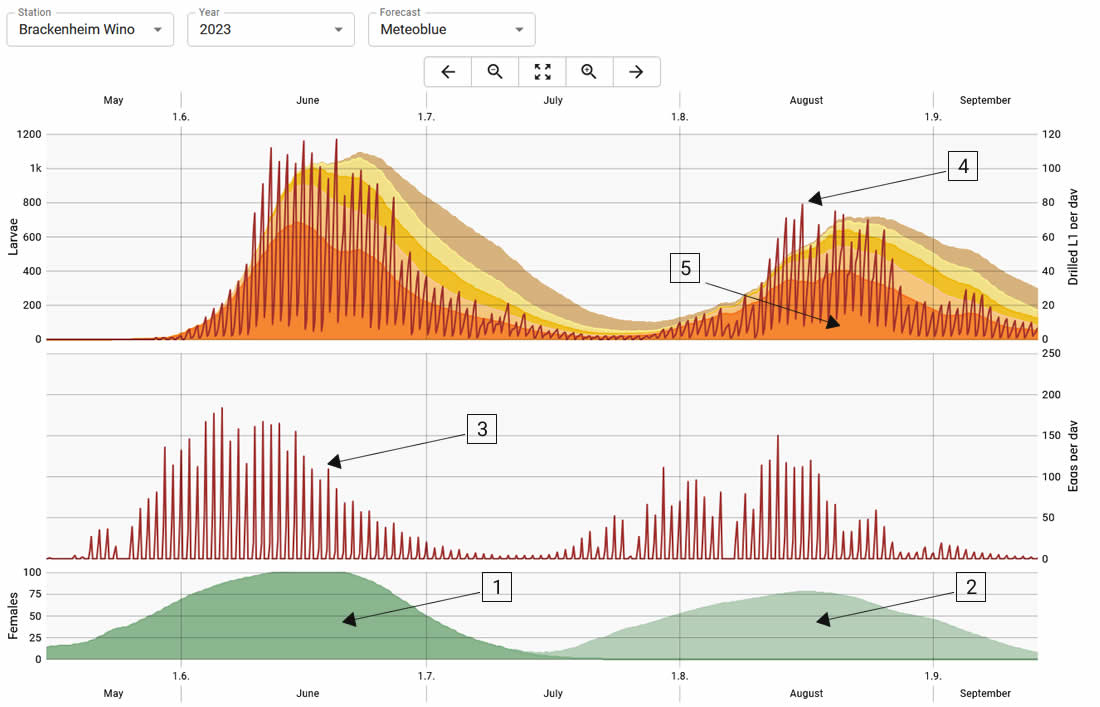Population model codling moth
The model is based on the codling moth model developed in Switzerland by Graf, Höhn, Höpli and Kuske in 2018. It is a population model, i.e. all stages are simulated, starting with the codling moth pupae in spring. When the model starts, 100 pupae are assumed.
Particular attention was paid to egg laying, the L1 larvae and the fresh holes made by the L1 larvae. Egg laying and holes made are each given per day. The occurrence of the moths (females) and the larval stages is shown as a sum and their development over time.
Starting point (Biofix):
If no settings are made in the model, the model begins on January 1st with the calculation of the temperature sum (T0 > 10°C, average 417 DD, SD 63) for the hatching of the female codling moths. The codling moth pupae develop at three different speeds. This depends on the exposure of the pupae to the sun. At the moment, the actual solar radiation is not used to calculate the development speed of the fast and medium codling moth pupae, but rather a flat rate surcharge is used. However, this will soon be changed to the method published by Graf et al. in 2003, which includes solar radiation.
Initial tests have shown that the calculation of the start of flight works very well with this method. This applies in particular to the region of southern Germany and the Altes Land. If there are deviations in other regions, it is possible to start the model manually by entering the start of flight (pheromone trap). The first butterflies caught in the region are crucial here. So please ask your advisors about this date.
The flight of the females is shown in the graphic at the bottom. The females of the first generation are shown as a dark green area (1) and the females of the second generation as a light green area (2). Currently only two generations are simulated.
Fertility of females
According to studies by Graf et al. 2018, fertility is highest at the beginning of their egg-laying activity (after the preoviposition phase) and then decreases significantly over time. Graf et al. 2018 work with a Weibull distribution. We have approximated this with an Erlang distribution (To > 10°C, mean 115 DD, SD 66).
Egg-laying
The female codling moths lay their eggs in the evening hours during twilight. The intensity of egg-laying depends on 3 factors
- Time of day: Egg-laying takes place before and after sunset. We used a normal distribution to determine the intensity of egg-laying activity over time. The highest intensity occurs at sunset (mean 2 hours, SD 0.5 hours).
- Weather conditions: the intensity of egg-laying depends on temperature. No egg-laying takes place below 14°C. The optimum temperature is 23 to 25°C. Above 31°C, no eggs are laid. Egg laying is interrupted when it rains.
- Fertility: see above
The graph always shows egg laying per day (3). This makes it very easy to see in which phases egg laying is particularly high or low.
Egg and larval development
The following parameters are used for the development of the eggs and the various larval stages
| Stage of developement | Mean DD | SD in % | Development threshold To | Distribution |
|---|---|---|---|---|
| Eggs | 78 | 10 | 10°C | Erlang |
| L1 Larvae | 45 | 10 | 10°C | Erlang |
| L2 Larvae | 45 | 10 | 10°C | Erlang |
| L3 Larvae | 45 | 10 | 10°C | Erlang |
| L4 Larvae | 55 | 10 | 10°C | Erlang |
| L5 Larvae | 120 | 10 | 10°C | Erlang |
| Puppae | 159 | 6 | 10°C | Erlang |
Each stage was subjected to two developmental speeds. Firstly, the temperature sum was calculated on the basis of the measured air temperature and secondly, an additional value was included for the part of the population that is exposed to direct sunlight (analogous to post-diapause development).
Larval hatching
The larval hatching is shown in the top line as larval hatching per day (4). In addition, the number of the five larval stages can be read as differently colored areas. The most important larval stage L1 is shown at the very bottom in orange (5).
Calculation method
The fruitweb codling moth model was developed on the basis of the time varying distributed delay model (Manetsch 1976). This makes it possible to calculate the development of each simulated individual with a time interval of 30 minutes. The transitions between the different stages (egg, larva, pupa and adult) are therefore not normally distributed, but follow an Erlang distribution.
Literature
T.J. Manetsch (1976). Time-varying distributed delays and their use in aggregative models of large systems. IEEE Transactions on Systems, Man, and Cybernetics 6: 547–553.
B. Graf, H. Höhn, H.U.Höpli und S. Kuske (2018). Predicting the phenology of codling moth, Cydia pomonella, for sustainable pest management in Swiss apple orchards. The Netherlands Entomological Society Entomologia Experimentalis et Applicata 166: 618-627
B. Graf, H.U. Höpli und H. Höhn (2003). Optimizing insect pest management in apple orchards with SOPRA. Bulletin IOBC/SROP, Vol.26 No.11:43-48

